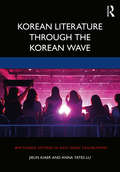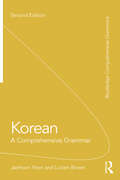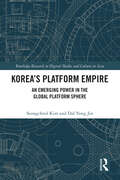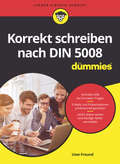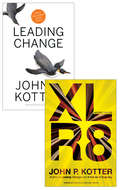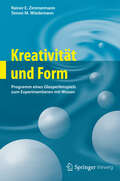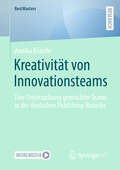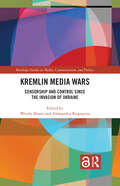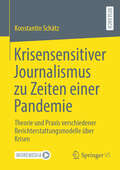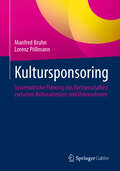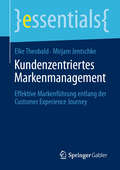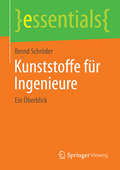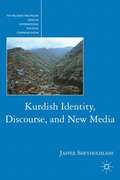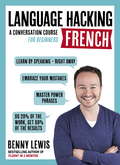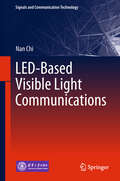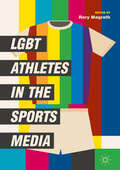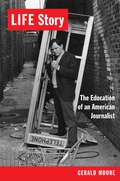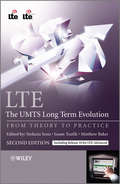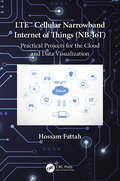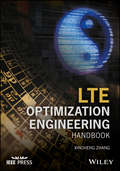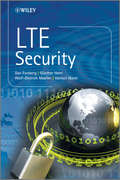- Table View
- List View
Korean Literature Through the Korean Wave
by Jieun Kiaer Anna Yates-LuKorean Literature Through the Korean Wave engages with the rising interest in both the Korean Wave and Korean language learning by incorporating Korean Wave cultural content, especially K-dramas, films and songs, to underline and support the teaching of Korean literature. It combines both premodern and modern texts, including poetry, novels, philosophical treatises, and even comics, to showcase the diversity of Korean literature. Particular care has been taken to include the voices of those marginalised in the often male, elite-dominated discourse on Korean literature. In particular, this book also distinguishes itself by extending the usual breadth of what is considered modern Korean literature up until the present day, including texts published as recently as 2017. Many of these texts are very relevant for recent discourse in Korean affairs, such as the obsession with physical appearance, the #MeToo movement and multiculturalism. This textbook is aimed at B1-B2 level and Intermediate-Mid students of Korean. On the one hand the textbook introduces students to seeing beyond Korean literature as a monolithic entity, giving a taste of its wonderful richness and diversity. On the other hand, it provides an entry point into discussions on Korean contemporary society, in which the text (and associated media extracts) provides the catalyst for more in-depth analysis and debate.
Korean Slanguage: A Fun Visual Guide to Korean Terms and Phrases
by Mike EllisJust in time for the 2018 Olympics, Korean Slanguage provides translations and pronunciation guides for approximately 300 English words and phrases. Just use the pronunciation guide to say them out loud, and soon you’ll be speaking basic Korean words and phrases like “It’s cool” (Show Not Dad) and “Are you okay?” (Quinn Send Eye Oh?). Fun and helpful illustrations paired with easy English words to pronounce will have you speaking Korean in no time. Both Hangul and romanized versions of the Korean terms are provided.
Korean: A Comprehensive Grammar
by Jaehoon Yeon Lucien BrownKorean: A Comprehensive Grammar is a reference to Korean grammar, and presents a thorough overview of the language, concentrating on the real patterns of use in modern Korean. The book moves from the alphabet and pronunciation through morphology and word classes to a detailed analysis of sentence structures and semantic features such as aspect, tense, speech styles and negation. Updated and revised, this new edition includes lively descriptions of Korean grammar, taking into account the latest research in Korean linguistics. More lower-frequency grammar patterns have been added, and extra examples have been included throughout the text. The unrivalled depth and range of this updated edition of Korean: A Comprehensive Grammar makes it an essential reference source on the Korean language.
Korea’s Platform Empire: An Emerging Power in the Global Platform Sphere (Routledge Research in Digital Media and Culture in Asia)
by Dal Yong Jin Seongcheol KimKorea’s Platform Empire explores the evolution of digital platforms in South Korea’s media sphere, and their global political, economic, cultural, and technological influence.With a focus on Korea in the context of the global platform revolution, the book takes a methodical look at the broader social implications and the impact on cultural production. The authors explore various facets of the media and cultural industries—looking beyond social media to news broadcasting and the music industry—and look at the policy and regulations behind this shifting technological advancement.This book will appeal to students and scholars working on media industries, digital media, platform studies, information and technology studies, Korean and East Asian media studies, and the creative and cultural industries.
Korrekt schreiben nach DIN 5008 für Dummies (Für Dummies)
by Uwe FreundMöchten Sie mit Ihren Texten und Schriftstücken gut ankommen? Eine Bewerbung oder ein Angebot mit formalen Fehlern werden schnell im ersten Durchgang aussortiert. Die Schreiber von fehlerhaften und altbackenen E-Mails werden oft auch fachlich für inkompetent gehalten. Dieses Buch richtet sich an alle, die im Beruf und privat jeweils korrekt und wirkungsvoll schreiben möchten oder müssen. Es zeigt Ihnen, welche Normen und Vorgaben es gibt, welche sinnvoll und hilfreich sind ? und wo sie gezielt von den Normen abweichen sollten.
Kotter on Accelerating Change
by John P. KotterThis collection offers the full digital editions of two seminal books by global leadership expert John P. Kotter: his international bestseller, Leading Change, and Accelerate, his award-winning framework for enabling companies to compete and win in a world of constant turbulence and disruption.Leading Change-now considered the change bible for leaders and managers worldwide-reveals why change is so difficult and lays out an actionable, eight-step process for implementing successful transformations. Cited by business leaders and influential organizations worldwide as the book to read when starting any type of change initiative, Accelerate (XLR8) vividly illustrates the five core principles underlying a new dual operating system, the eight accelerators that drive it, and how leaders must create a sense of urgency through role modeling. Perhaps most crucial, the book reveals how the best companies focus and align their people's energy around what Kotter calls the big opportunity.If you're a pioneer, a leader who knows that bold change is necessary to survive and thrive in an ever-changing world, these two books will set you on a path to accelerate into a better, more profitable future.Regarded by many as the authority on leadership and change, John P. Kotter is a New York Times bestselling author, award-winning business and management thought leader, business entrepreneur, inspirational speaker, and Harvard Business School professor. His ideas, books, speeches, and the company he founded in 2008, Kotter International, have helped mobilize people around the world to better lead organizations, and their own lives, in an era of increasingly rapid change. Kotter has authored nineteen books to date-twelve of them bestsellers. His books have reached millions and have been printed in over 150 foreign language editions.
Kreativität und Form
by Simon M. Wiedemann Rainer E. ZimmermannAusgehend von der Idee des Glasperlenspiels, die Hermann Hesse in seinem gleichnamigen Roman entwirft, haben die Autoren in diesem Band die Möglichkeiten und Grenzen eines solchen Spiels im Umgang mit Wissen ausgelotet. Sie zeigen neue Methoden für das Wissensmanagement auf und verbinden dafür Erkenntnisse verschiedener Wissenschaftsgebiete wie Logik, System- und Erkenntnistheorie sowie Semiotik, Kognition und Kommunikation. Das begleitende Computerprogramm unterstützt Leser beim Experimentieren mit Wissen.
Kreativität von Innovationsteams: Eine Untersuchung gemischter Teams in der deutschen Publishing-Branche (BestMasters)
by Annika KräutleDie Publishing-Branche ist angesichts der Digitalisierung, disruptiver Technologien und eines sich wandelnden Verbraucherverhaltens mit erheblichen Veränderungen konfrontiert. Klassische Geschäftsmodelle erodieren, wodurch der Innovationsdruck auf Verlage weiter steigt. In diesem dynamischen Umfeld gewinnen kreative, interdisziplinäre Innovationsteams zunehmend an Bedeutung, um die Zukunftsfähigkeit der Verlage zu sichern. In diesem Buch untersucht Annika Kräutle, wie solche Innovationsteams in der deutschen Publishing-Branche optimal besetzt werden sollten, um ihre Kreativität maximal auszuschöpfen. Dabei werden Merkmale wie Alter, Geschlecht und Fachkompetenz der Teammitglieder analysiert, um Rückschlüsse auf eine kreative und effiziente Teamzusammensetzung zu ziehen. Die Arbeit basiert auf einem zweiphasigen Forschungsdesign aus qualitativen Experteninterviews und einer quantitativen Befragung. Ziel ist es, praxisrelevante Erkenntnisse zur Besetzung von Innovationsteams zu gewinnen.
Kremlin Media Wars: Censorship and Control Since the Invasion of Ukraine (Routledge Studies in Media, Communication, and Politics)
by Wendy Sloane Aleksandra RaspopinaThis unique volume brings together academics of Russian journalism and media with journalists and editors who reported or continue to report on the country, to explore and reflect on the changing landscape for journalists in Russia or covering Russia, and the increasing control exerted by the government on independent journalists.Combining rigorous academic research with reflective practitioner essays, the volume investigates the future of reporting in Russia and the implications for the future of the country. It offers an understanding of the experience of independent journalists and media outlets in Russia, as well as other individuals who experience censorship (academics, activists), and examines how the current situation in Russia and people’s experiences of censorship can inform both our theoretical understandings of censorship and information control, in the context of the twenty‑first‑century digital technologies and the policymaking both inside and outside of Russia.Offering important insight into what is happening within Russia’s borders, this volume will appeal to researchers and students of journalism, political science, international relations, propaganda and censorship, mass media, as well as journalists and policymakers.Chapter 4 of this book is freely available as a downloadable Open Access PDF at http://www.taylorfrancis.com under a Creative Commons Attribution-Non Commercial-No Derivatives (CC BY-NC-ND) 4.0 license.
Krisensensitiver Journalismus zu Zeiten einer Pandemie: Theorie und Praxis verschiedener Berichterstattungsmodelle über Krisen
by Konstantin SchätzDer Journalismus hat in der Berichterstattung über die Covid-19-Krise versagt. Diese Meinung vertreten viele aus unterschiedlichen Bereichen der Gesellschaft. Ausgehend von der Medienkritik wird in diesem Buch die Qualität der Berichterstattung ausgewählter deutscher und österreichischer Medien in Krisenzeiten geprüft. Dazu bedarf es unterschiedlicher Modelle, Theorien und Ansätze, mithilfe derer sich Qualität von Journalismus bewerten lässt. Dabei sind nicht nur Erkenntnisse wichtig, die in der kommunikationswissenschaftlichen Auseinandersetzung mit Journalismus gesammelt wurden. Auch psychologische Modelle und Diskussionen aus der Praxis um Ethik und gesellschaftliche Rollen von Medien sind zentral. Die Annahme, dass unterschiedliche Phasen einer Krise berücksichtigt werden müssen, ist ein zentraler Bestandteil dieser Analyse. Auf Grundlage der erarbeiteten Erkenntnisse steht die Frage im Mittelpunkt, wie Medien in Zeiten einer Krise berichten müssen, um ihrer sozialen Verantwortung nachzukommen und gesellschaftlicher Verunsicherung im besten Fall sogar entgegenwirken zu können. Ziel der Forschung ist die Erarbeitung eines Kriterienkatalogs, die Untersuchung der Berichterstattung in Zeiten der Pandemie und damit auch die Überprüfung der geäußerten Medienkritik.
Kultursponsoring: Systematische Planung von Partnerschaften zwischen Kulturakteuren und Unternehmen
by Manfred Bruhn Lorenz PöllmannKultursponsoring verbindet das kulturelle Engagement von Unternehmen mit strategischer Unternehmens- und Marketingkommunikation. Es basiert auf der externen Kooperation mit Kulturinstitutionen und der internen Zusammenarbeit mit verschiedenen Kommunikationsabteilungen des Unternehmens. Ziel dieses Buches ist es, die gesamte Bandbreite der vielfältigen Einsatzmöglichkeiten von Kultursponsoring als Baustein einer integrierten Kommunikation aufzuzeigen. Die systematische Darstellung der einzelnen Schritte zur Erstellung einer Sponsoringkonzeption ermöglicht es den Lesenden, die Chancen und Risiken des Einsatzes von Kultursponsoring zu erkennen und darauf aufbauend eine eigenständige unternehmensspezifische Kultursponsoring-Strategie zu entwickeln. Fallstudien aus der Perspektive von Sponsoren und Gesponserten ermöglichen einen Praxiseinblick sowie ein Inspirations- bzw. Reflexionsangebot für die eigene Strategie des Kultursponsoring. Der Inhalt • Begriff und Grundlagen des Kultursponsoring • Erscheinungsformen des Kultursponsoring • Einordnung des Kultursponsoring in die Kulturfinanzierung • Managementprozess des Kultursponsoring und Kultursponsoring-Canvas • Situationsanalyse im Kultursponsoring • Ziele und Zielgruppen des Kultursponsoring • Entwicklung einer Strategie des Kultursponsoring • Auswahl von Kultursponsorships • Operative Gestaltung des Kultursponsoring • Einordnung des Kultursponsoring in die Marketing- und Unternehmenskommunikation • Erfolgskontrolle im Kultursponsoring • Tendenzen im Einsatz des Kultursponsoring
Kundenzentriertes Markenmanagement: Effektive Markenführung entlang der Customer Experience Journey (essentials)
by Elke Theobald Mirjam JentschkeDieses essential beschreibt, wie sich Markenmanagement ändern muss, um einem durch die Digitalisierung geprägtem Kundenverständnis gerecht zu werden. Starre Konstrukte wie die Markenpositionierung, Markendifferenzierung oder Markenkonsistenz werden durch die Ausrichtung am Kunden, die Customer Experience und die Customer Centricity in Frage gestellt. Das Buch beantwortet die zentralen Fragestellungen des Zusammenspiels von Markenmanagement und Customer Experience Management und stützt sich dabei unter anderem auf eine aktuelle Umfrage unter Marketingentscheidern. Die Neuausrichtung des Markenmanagements, vom Persona-Ansatz über die Consumer Experience Journey bis hin zu organisatorischen Aspekten, wird umsetzungsorientiert dargestellt.
Kunststoffe für Ingenieure: Ein Überblick (essentials)
by Bernd SchröderFür die Auswahl geeigneter Kunststoffe ist es hilfreich, die physikalisch-technischen Eigenschaften der Materialien zu kennen. Entsprechend den Gruppen Duroplaste, Thermoplaste, Elastomere und Schäume werden die Eigenschaften aufgelistet und Anwendungsbereiche erläutert.
Kurdish Identity, Discourse, and New Media
by Jaffer SheyholislamiInformed by the interdisciplinary approach of Critical Discourse Analysis (CDA) and theories of identity, nation, and media, this study investigates the ways Kurds, the world's largest stateless nation, use satellite television and Internet to construct their identities. This book examines the complex interrelationships between ethno-national identities, discourses, and new media. Not only does this book offer the first study of discursive constructions of Kurdish identity in the new media,this book is also the first CDA-informed comparative study of the contents of the two media. The study pushes the boundaries of the growing area of studies of identity, nationalism and transnationalism, discourse studies, minority language, and digital media.
Kurukshetra May 2019
by Publication DivisionThis is a monthly magazine of Kurukshetra May 2019 of this year.
Künstliche Intelligenz und Marketing: Anwendung in der Anzeigenwerbung zur Werbeeffektivität und Akzeptanz (BestMasters)
by Philip SchäferBei der Werbeforschung in Bezug auf Anzeigenwerbung gibt es diverse Variablen, welche sich auf die Werbeeffektivität und Akzeptanz von Anzeigen auswirken und durch äußere Umstände beeinflusst werden können. Dabei untersucht dieser Band den Einfluss des Erstellungsprozesses einer Anzeigenwerbung, wobei die Anzeigen zu High- und Low-Involvement-Produkten zum einen durch eine künstliche Intelligenz und zum andern durch einen Marketingexperten erstellt wurden, auf dessen Werbeeffektivität und Akzeptanz beim Rezipienten. Methodisch wird dabei in einem Within-subjects-Design ein Online-Experiment zur Erhebung der Werbeeffektivität durchgeführt. Ein Between-subjects-Design wurde angewandt, um die Akzeptanz der Anzeigenwerbung zu überprüfen. Die Stichprobe bestand aus insgesamt 104 Versuchsteilnehmenden, die das durchgeführte Experiment vollkommen beendet haben. Die gefundenen empirischen Ergebnisse gehen im Wesentlichen einher mit den bisherigen Forschungen zu diesen Themen.
L'illa dels 5 fars (edició ampliada i actualitzada): Com millorar la nostra comunicació i fer-la més memorable
by Ferran Ramón-CortesEdició ampliada i revisada del llibre de referència de la comunicació personal que ja ha conquistat més de 100.000 lectors. «Ves a Menorca i, cada nit, dedica't a observar el que sé que tant t'agrada: els fars. Ells et podran ensenyar millor que jo. Observa'ls, sense presses, amb els ulls ben oberts.» Aquest és el sorprenent suggeriment que, després d'una mediocre presentació en públic, el Ferran rep del Max, el seu vell amic i professor. I, sense dubtar-ho dues vegades, decideix seguir el consell al peu de la lletra i inicia un recorregut pels cinc fars principals de l'illa de Menorca, que li descobriran com millorar la seva comunicació i fer-la més memorable. Observant-los amb deteniment, el Ferran troba en cada far una clau que l'ajudarà a fer que els seus missatges arribin amb claredat i efectivitat als seus destinataris. Aquesta petita història és molt útil per a tots aquells que en algun moment de lanostra vida hem de fer arribar de manera clara el nostre missatge als altres, tant en el terreny personal com professional, als nostres fills, als nostres clients, als nostres companys de feina o als nostres alumnes. «Aquest és un llibre per comunicar. Per comunicar-se. Davant de mil persones o de dues. A la feina o a la nostra vida personal. Els secrets són els mateixos.» Ferran Ramon-Cortés Ressenyes: «L'illa dels 5 fars és una invitació magistral a convertir-nos en grans comunicadors. Ferran Ramon-Cortés ens porta, a través d'una història inspiradora, càlida i pròxima, a trobar les claus d'una comunicació altament efectiva.»Rosa Moreno, directora de Recursos Humans & Comunicació Corporativa de Grünenthal Pharma «Cinc fars, cinc claus, cinc històries. Una illa, un escriptor i un llibre. Un llibre clar i senzill d'obligada lectura per a tothom.»Guayente Sanmartín, vicepresidenta global i directora general 3D Multi Jet Fusion en HP «Poques coses hi ha tan humanes i centrals com comunicar-nos. L'illa dels 5 fars ens orienta en aquest art.»Sergi Aulinas, director general de Laboratorios Gebro Pharma «En les organitzacions el talent sense habilitats de comunicació és com la potència sense tracció.»Narcís Roura, director general PepsiCo SWE
LANGUAGE HACKING FRENCH (Learn How to Speak French - Right Away): A Conversation Course for Beginners
by Benny LewisCrack the Code and Get Fluent Faster!"I had to learn [a new language] in a handful of days for a TV interview. I asked Benny for help and his advice was invaluable." - Tim Ferriss What if you could skip the years of study and jump right to speaking French? Sound crazy? No, it's language hacking. It's about learning what's indispensable, skipping what's not - and using what you've learned to have real conversations in French - from day one!Unlike most traditional language courses that try to teach you the rules of a language, Language Hacking French shows you how to learn and speak French immediately through proven memory techniques, unconventional shortcuts and conversation strategies perfect by one of the world's greatest language learners, Benny Lewis, aka the Irish Polyglot. The Method Language Hacking takes a modern approach to language learning, blending the power of online social collaboration and the 80/20 principle of learning (Benny's ten #languagehacks show you how to achieve more with less!). It focuses on the conversations and language that learners need to master right away, rather than presenting language in the order of difficulty like most courses. This means you can start having conversations immediately. Course FeaturesEach of the 10 units culminates with a speaking mission that you can choose to share on the italki Language Hacking learner community (www.italki.com/languagehacking) where you can give and get feedback and extend your learning beyond the pages of the book. The audio for this course is available for free on library.teachyourself.com or from the Teach Yourself Library app.You don't need to go abroad to learn a language any more.
LED-Based Visible Light Communications (Signals and Communication Technology)
by Nan ChiThe book systematically introduces the visible light communication (VLC) technology in detail. Basic concepts and how to realize the system are both illustrated, including the transmitter, channel, and the receiver. In addition, a good many experimental results are presented to help readers further understand the VLC technologies. The upper-layer protocols of visible light communication system and the technology trends are also discussed. This book can be a good reference work for researchers, engineers, and graduate students in the fields of communications, LED, and optics.
LGBT Athletes in the Sports Media
by Rory MagrathIn recent years, lesbian, gay, bisexual, and transgender (LGBT) athletes have received more media attention than ever before. Declining levels of homophobia across the Western world has facilitated a greater acceptance of LGBT athletes among heterosexual teammates, fans, and the sports media. Consequently, academic interest in sport, gender and sexuality has also increased substantially. This edited collection combines studies of gender and sexuality with that of the sports media to provide the first-ever comprehensive academic overview of LGBT athletes in the sports media. It draws upon work from a wide range of international scholars to provide an interdisciplinary analysis of improved media coverage of LGBT athletes, as well as the numerous issues and barriers which continue to exist. LGBT Athletes in the Sports Media will be of interest to students and scholars across a range of disciplines, including sociology, media studies, and gender studies.
LIFE Story: The Education of an American Journalist
by Gerald MooreBefore Americans got their news from television, they got it from LIFE, the weekly magazine that set the standard for photojournalism. In LIFE Story Gerald Moore—a writer and editor who worked at the magazine in the last glory years before TV made it obsolete—recalls the dizzying excitement and glamour of LIFE&’s fast-moving, powerful approach to spreading the news. Moore covered the major stories of the late 1960s and early 1970s: LSD, assassinations, the 1968 Democratic convention in Chicago, the McCarthy campaign, urban riots, the My Lai massacre, and the beginnings of feminism. Before joining LIFE at the age of twenty-seven, he worked as a police officer in Albuquerque and then a reporter at the Albuquerque Tribune—both jobs teaching him the tools of his trade. His story offers a wonderful look back at the good and the bad old days of journalism.
LTE - The UMTS Long Term Evolution
by Stefania Sesia Issam Toufik Matthew Baker"Where this book is exceptional is that the reader will not just learn how LTE works but why it works"Adrian Scrase, ETSI Vice-President, International Partnership ProjectsFollowing on the success of the first edition, this book is fully updated, covering the latest additions to LTE and the key features of LTE-Advanced.This book builds on the success of its predecessor, offering the same comprehensive system-level understanding built on explanations of the underlying theory, now expanded to include complete coverage of Release 9 and the developing specifications for LTE-Advanced. The book is a collaborative effort of more than 40 key experts representing over 20 companies actively participating in the development of LTE, as well as academia. The book highlights practical implications, illustrates the expected performance, and draws comparisons with the well-known WCDMA/HSPA standards. The authors not only pay special attention to the physical layer, giving an insight into the fundamental concepts of OFDMA-FDMA and MIMO, but also cover the higher protocol layers and system architecture to enable the reader to gain an overall understanding of the system.Key New Features:Comprehensively updated with the latest changes of the LTE Release 8 specifications, including improved coverage of Radio Resource Management RF aspects and performance requirementsProvides detailed coverage of the new LTE Release 9 features, including: eMBMS, dual-layer beamforming, user equipment positioning, home eNodeBs / femtocells and pico cells and self-optimizing networksEvaluates the LTE system performanceIntroduces LTE-Advanced, explaining its context and motivation, as well as the key new features including: carrier aggregation, relaying, high-order MIMO, and Cooperative Multi-Point transmission (CoMP).Includes an accompanying website containing a complete list of acronyms related to LTE and LTE-Advanced, with a brief description of each (http://www.wiley.com/go/sesia_theumts)This book is an invaluable reference for all research and development engineers involved in implementation of LTE or LTE-Advanced, as well as graduate and PhD students in wireless communications. Network operators, service providers and R&D managers will also find this book insightful.
LTE Cellular Narrowband Internet of Things (NB-IoT): Practical Projects for the Cloud and Data Visualization
by Hossam FattahNB-IoT is the Internet of Things (IoT) technology used for cellular communication. NB-IoT devices deliver much better capability and performance, such as: increased area coverage of up to one kilometer; a massive number of devices—up to 200,000—per a single base-station area; longer battery lifetime of ten years; and better indoor and outdoor coverage for areas with weak signal, such as underground garages. The cellular NB-IoT technology is a challenging technology to use and understand. With more than 30 projects presented in this book, covering many use cases and scenarios, this book provides hands-on and practical experience of how to use the cellular NB-IoT for smart applications using Arduino™, Amazon Cloud, Google Maps, and charts. The book starts by explaining AT commands used to configure the NB-IoT modem; data serialization and deserialization; how to set up the cloud for connecting NB-IoT devices; setting up rules, policy, security certificates, and a NoSQL database on the cloud; how to store and read data in the cloud; how to use Google Maps to visualize NB-IoT device geo-location; and how to use charts to visualize sensor datasets. Projects for Arduino are presented in four parts. The first part explains how to connect the device to the mobile operator and cellular network; perform communication using different network protocols, such as TCP, HTTP, SSL, or MQTT; how to use GPS for geo-location applications; and how to upgrade NB-IoT modem firmware over the air. The second part explains the microcontroller unit and how to build and run projects, such as a 7-segment display or a real-time clock. The third part explains how NB-IoT can be used with sensor devices, such as ultrasonic and environmental sensors. Finally, the fourth part explains how NB-IoT can be used to control actuators, such as stepper motors and relays. This book is a unique resource for understanding practical uses of the NB-IoT technology and serves as a handbook for technical and non-technical readers who are looking for practicing and exercising the cellular NB-IoT technology. The book can be used by engineers, students, researchers, system integrators, mobile operators’ technical staff, and electronics enthusiasts. To download the software which can be used with the book, go to: https://github.com/5ghub/NB-IoT About the Author: Hossam Fattah is a technology expert in 4G/5G wireless systems and networking. He received his Ph.D. in Electrical and Computer Engineering from University of British Columbia, Vancouver, Canada in 2003. He received his Master of Applied Science in Electrical and Computer Engineering from University of Victoria, Victoria, Canada in 2000. He completed his B.Sc. degree in Computers and Systems Engineering from Al-Azhar University, Cairo, Egypt in 1995. Between 2003 and 2011, he was in academia and industry, including Texas A&M University. Between 2011 and 2013, he was with Spirent Communications, NJ, USA. Since 2013, he has been with Microsoft, USA. He is also an affiliate associate professor at University of Washington, Tacoma, WA, USA, teaching graduate courses on IoT and distributed systems and collaborating on 5G research and innovations. He has had many patents and technical publications in conferences and journals. He is a registered professional Engineer with the Association of Professional Engineers, British Columbia, Canada. He is the author of the recent book 5G LTE Narrowband Internet of Things (NB-IoT). His research interest is in wireless communications and radio networks and protocols, cellular quality of service, radio resource management, traffic and packet scheduling, network analytics, and mobility.
LTE Optimization Engineering Handbook
by Xincheng ZhangA comprehensive resource containing the operating principles and key insights of LTE networks performance optimization LTE Optimization Engineering Handbook is a comprehensive reference that describes the most current technologies and optimization principles for LTE networks. The text offers an introduction to the basics of LTE architecture, services and technologies and includes details on the key principles and methods of LTE optimization and its parameters. In addition, the author clarifies different optimization aspects such as wireless channel optimization, data optimization, CSFB, VoLTE, and video optimization. With the ubiquitous usage and increased development of mobile networks and smart devices, LTE is the 4G network that will be the only mainstream technology in the current mobile communication system and in the near future. Designed for use by researchers, engineers and operators working in the field of mobile communications and written by a noted engineer and experienced researcher, the LTE Optimization Engineering Handbook provides an essential guide that: Discusses the latest optimization engineering technologies of LTE networks and explores their implementation Features the latest and most industrially relevant applications, such as VoLTE and HetNets Includes a wealth of detailed scenarios and optimization real-world case studies Professionals in the field will find the LTE Optimization Engineering Handbook to be their go-to reference that includes a thorough and complete examination of LTE networks, their operating principles, and the most current information to performance optimization.
LTE Security
by Wolf-Dietrich Moeller Dan Forsberg Valtteri Niemi Günther HornA concise, updated guide to the 3GPP LTE Security Standardization specificationsA welcome Revised Edition of the successful LTE Security addressing the security architecture for SAE/LTE, which is based on elements of the security architectures for GSM and 3G, but which needed a major redesign due to the significantly increased complexity, and different architectural and business requirements of fourth generation systems. The authors explain in detail the security mechanisms employed to meet these requirements. The specifications generated by standardization bodies only inform about how to implement the system (and this only to the extent required for interoperability), but almost never inform readers about why things are done the way they are. Furthermore, specifications tend to be readable only for a small group of experts and lack the context of the broader picture. The book fills this gap by providing first hand information from insiders who participated in decisively shaping SAE/LTE security in the relevant standardization body, 3GPP, and can therefore explain the rationale for design decisions in this area.A concise, fully updated guide to the 3GPP LTE Security Standardization specificationsDescribes the essential elements of LTE and SAE Security, written by leading experts who participated in decisively shaping SAE/LTE security in the relevant standardization body, 3GPPExplains the rationale behind the standards specifications giving readers a broader understanding of the context to these specificationsIncludes new chapters covering 3GPP work on system enhancements for MTC, plus application layer security in ETSI TC M2M and embedded smart card in ETSI SCP; Security for Machine-type Communication, Relay Node Security, and Future Challenges, including Voice over LTE, MTC, Home base stations, LIPA/SIPTO, and New Cryptographic AlgorithmsEssential reading for System engineers, developers and people in technical sales working in the area of LTE and LTE security, communication engineers and software developers in mobile communication field.
